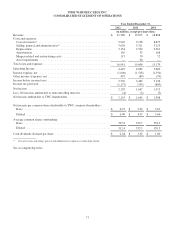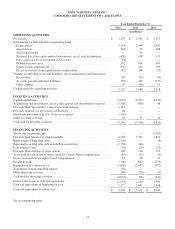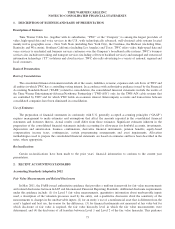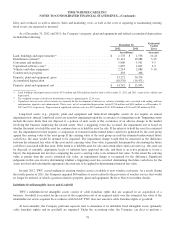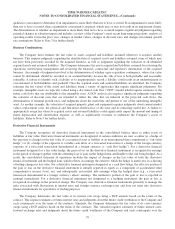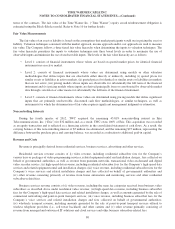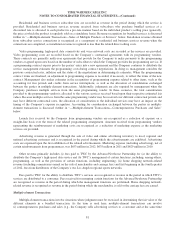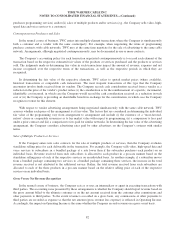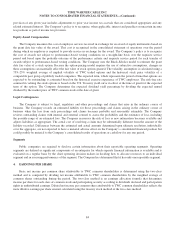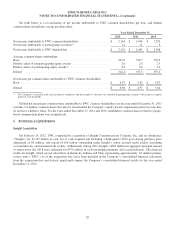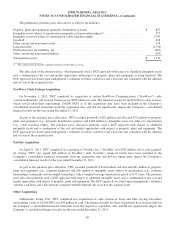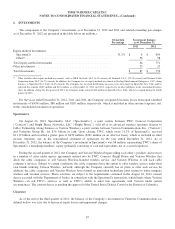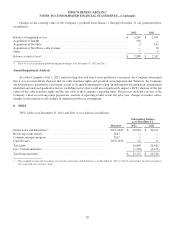Time Warner Cable 2012 Annual Report Download - page 89
Download and view the complete annual report
Please find page 89 of the 2012 Time Warner Cable annual report below. You can navigate through the pages in the report by either clicking on the pages listed below, or by using the keyword search tool below to find specific information within the annual report.TIME WARNER CABLE INC.
NOTES TO CONSOLIDATED FINANCIAL STATEMENTS—(Continued)
qualitative assessment to determine if an impairment is more likely than not to have occurred. If an impairment is more likely
than not to have occurred, then a quantitative assessment is required, which may or may not result in an impairment charge.
The determination of whether an impairment is more likely than not to have occurred requires significant judgment regarding
potential changes in valuation inputs and includes a review of the Company’s most recent long-range projections, analysis of
operating results versus the prior year, changes in market values, changes in discount rates and changes in terminal growth
rate assumptions. Refer to Note 7 for further details.
Business Combinations
The Company must estimate the fair value of assets acquired and liabilities assumed whenever it acquires another
business. This requires judgments regarding the identification of acquired assets and liabilities assumed, some of which may
not have been previously recorded by the acquired business, as well as judgments regarding the valuation of all identified
acquired assets and assumed liabilities. The Company determines the assets acquired and liabilities assumed by reviewing the
operations, interviewing management and reviewing the financial, contractual and regulatory information of the acquired
business. An example of judgment involved is the determination of whether a pre-acquisition contingency, whose fair value
cannot be determined, should be recorded as an assumed liability because the risk of loss is both probable and reasonably
estimable. A failure to identify such a liability or to inappropriately record a liability could result in an understatement or
overstatement of both liabilities and goodwill. Once the acquired assets and assumed liabilities are identified, the Company
estimates the fair values of the assets and liabilities using a variety of approaches that require significant judgments. For
example, intangible assets are typically valued using a discounted cash flow (“DCF”) model which requires estimates of the
future cash flows that are attributable to the intangible asset. A DCF analysis also requires significant judgments regarding
the selection of discount rates that are intended to reflect the risks that are inherent in the projected cash flows, the
determination of terminal growth rates, and judgments about the useful life and pattern of use of the underlying intangible
asset. As another example, the valuation of acquired property, plant and equipment requires judgments about current market
values, replacement costs, the physical and functional obsolescence of the asset and its remaining useful life. A failure to
appropriately assign fair values to acquired assets and assumed liabilities could significantly impact the amount and timing of
future depreciation and amortization expense, as well as significantly overstate or understate the Company’s assets or
liabilities. Refer to Note 5 for further details.
Derivative Financial Instruments
The Company recognizes all derivative financial instruments in the consolidated balance sheet as either assets or
liabilities at fair value. Derivative financial instruments are designated, if certain conditions are met, as either (a) a hedge of
the exposure to changes in the fair value of a recognized asset or liability or an unrecognized firm commitment (a “fair value
hedge”) or (b) a hedge of the exposure to variable cash flows of a forecasted transaction or a hedge of the foreign currency
exposure of a forecasted transaction denominated in a foreign currency (a “cash flow hedge”). For a derivative financial
instrument designated as a fair value hedge, the gain or loss on the derivative financial instrument is recognized in earnings
in the period of change together with the offsetting loss or gain on the hedged item attributable to the risk being hedged. As a
result, the consolidated statement of operations includes the impact of changes in the fair value of both the derivative
financial instrument and the hedged item, which reflects in earnings the extent to which the hedge is ineffective in achieving
offsetting changes in fair value. For a derivative financial instrument designated as a cash flow hedge, the effective portion of
the gain or loss on the derivative financial instrument is initially reported in equity as a component of accumulated other
comprehensive income (loss), net, and subsequently reclassified into earnings when the hedged item (e.g., a forecasted
transaction denominated in a foreign currency) affects earnings. The ineffective portion of the gain or loss is reported in
earnings immediately. For a derivative financial instrument not designated as a hedging instrument, the gain or loss is
recognized in earnings in the period of change. The Company uses derivative financial instruments primarily to manage the
risks associated with fluctuations in interest rates and foreign currency exchange rates and does not enter into derivative
financial instruments for speculative or trading purposes.
The Company determines the fair value of its interest rate swaps using a DCF analysis based on the terms of the
contract. This requires estimates of future interest rates and judgments about the future credit worthiness of the Company and
each counterparty over the terms of the contracts. Similarly, the Company determines the fair value of its cross-currency
swaps using a DCF analysis based on the terms of the contracts. This valuation requires estimates of future interest rates,
forward exchange rates and judgments about the future credit worthiness of the Company and each counterparty over the
79




